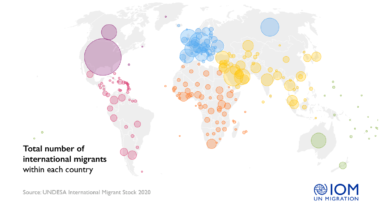New Report: COVID-19 and the State of Global Mobility in 2020
While the overall picture of cross-border human mobility in 2020 is of movement dramatically curtailed as a result of measures imposed by governments since the onset of the COVID-19 pandemic, a new report shows a varying reality over time and by region, with particularly harsh effects for refugees and other migrants who move out of necessity.
The report resulting from the collaboration by the International Organization for Migration (IOM) and the Migration Policy Institute (MPI) marks the first comprehensive analysis of the travel measures and border closures that governments around the world took during 2020 — which at their peak in mid-December exceeded 111,000 in place at one time.
The report, COVID-19 and the State of Global Mobility in 2020, results from MPI analysis of IOM’s COVID-19 Mobility Impacts platform, which collects all of the actions taken by countries and subnational authorities to close international borders, restrict travel between particular locations, impose quarantines and health requirements for travellers and establish “travel bubbles” and other arrangements.
“The COVID-19 pandemic has gravely impacted global mobility, stranding millions of people, migrant labourers, family members or international students overseas,” said IOM Director General António Vitorino. “This report draws out these dynamics over the course of 2020 and highlights the ways governments are attempting to restart mobility in 2021 and beyond.”
Cross-border mobility in 2020 can be divided into three phases, the report’s authors find:
January to May: Mobility lockdowns. In this first phase, countries introduced a raft of national lockdowns, other travel restrictions and health requirements to respond to the fast-evolving public health crisis. The scale of border closures was unprecedented, many occurring with limited coordination. By the end of March, governments had issued or extended 43,300 travel measures. Movements of all kinds were dramatically curtailed. For instance, the numbers of passengers on international flights in April and May were down by 92 per cent relative to the same months in 2019.
June to September: Phased reopening. This period brought the staggered reopening of some points of entry, especially of airports. Travel bans were increasingly replaced by health measures, including certificates of pre-departure COVID-19 tests, quarantine measures or health declarations. During this phase, different strategies across the world began to crystallize. This was obvious most clearly in the divergent approaches of island countries: as New Zealand and Australia pursued virus-elimination strategies and maintained border closures, others such as the Caribbean islands opened up to tourism.
October to December: Responses to new outbreaks and virus mutations. The remainder of the year was a mixed picture, as countries sought to replace travel restrictions with health requirements, while battling a second (and in some cases, third) wave of infections and grappling with the emergence of new variants of the virus. Some countries, including Chile, Mexico and the United Arab Emirates, opened even to tourists. Health certificates became the most common health-related travel measure.
Three shifts in cross-border mobility were particularly visible, and could persist in the years ahead:
Widening gulf between movers and non-movers. The pandemic has deeply curtailed the mobility prospects of some groups who move out of necessity, including refugees and migrant workers, while having little effect on business travellers and others with the resources and opportunity to cross borders for work, family or tourism. This gulf is especially likely to persist if travel begins to favour those who have been vaccinated or tested, or if reliance on digital health records makes a person’s ability to travel dependent on digital access and literacy.
Greater socioeconomic vulnerabilities. The pandemic has amplified the socioeconomic vulnerability of those who depend on mobility for survival. Job losses have hit migrant workers hard, especially since in many countries they often work in sectors particularly disrupted by pandemic response measures or with a higher infection risk.
Amplified relationships of dependence and exploitation. Restrictions on movement have increased the dependence of many migrants on intermediaries and facilitators, from employment agencies to smugglers. Even as fast-changing travel restrictions have increased the demand for smuggling services among people desperate to flee violence, natural disasters and economic deprivation, or to be able to return home, they have pushed smugglers to use more dangerous routes and raise their prices — exposing migrants and refugees to an increased risk of exploitation and trafficking.
The report examines the future of mobility as countries begin to emerge slowly from the pandemic, finding no easy or one-size-fits-all answers.
“More than a year on from the onset of the pandemic, it remains an open question what role border closures, travel restrictions and health-related travel requirements should play in a pandemic management response,” said MPI President Andrew Selee. “As new strains of the virus emerge, governments face the challenge of developing risk mitigation strategies that move beyond the blunt tools of border closures and travel bans. They also need to avoid unilateral responses and work with other governments and international organizations to develop well-planned border health policies.”
Further details can be found here >>




